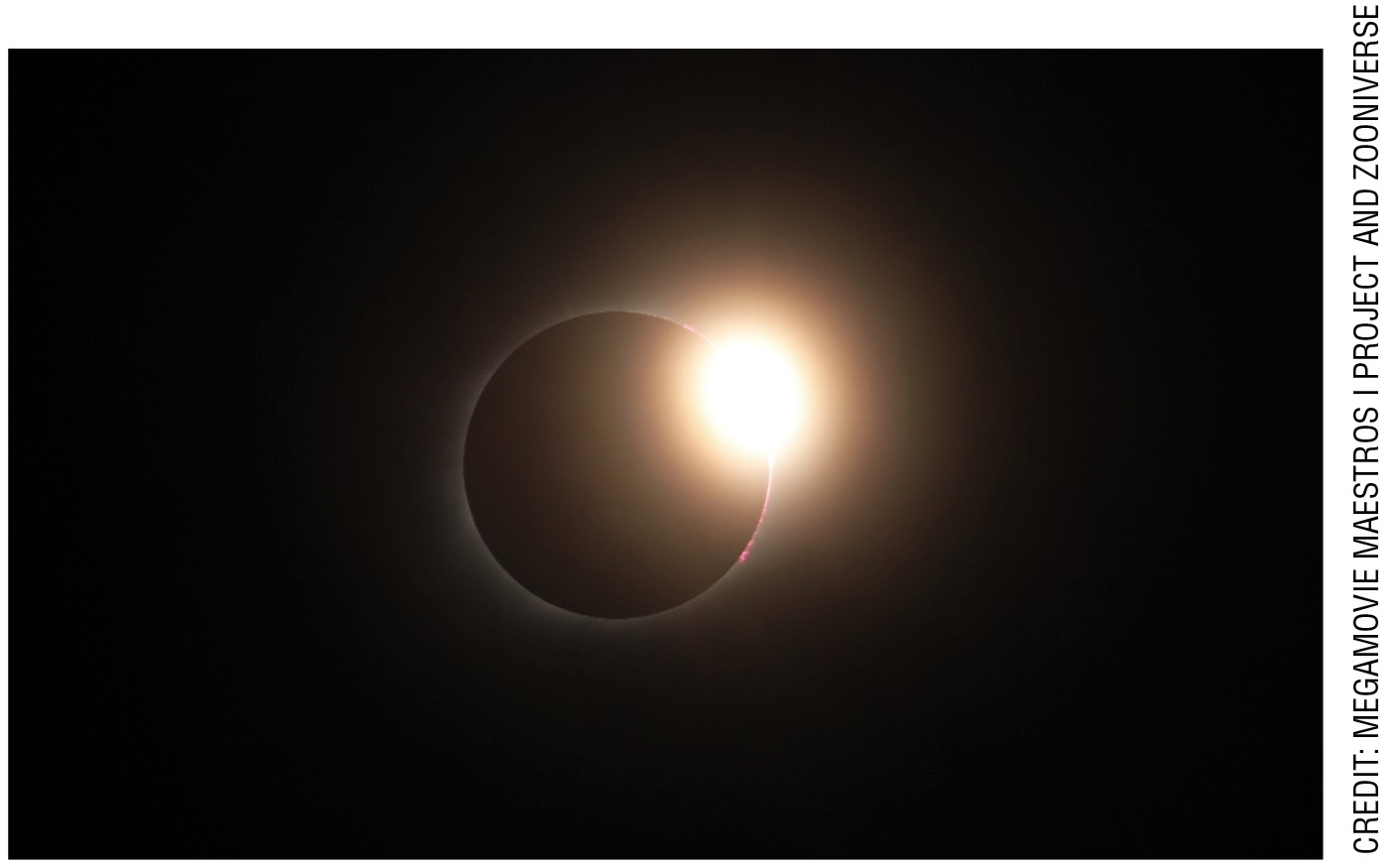citizen science
Megamovie 2024: A Project to Eclipse All Others
Science Scope—July/August 2023 (Volume 46, Issue 6)
By Jill Nugent
On August 21, 2017, the first total solar eclipse took place in the United States in nearly 100 years. A total solar eclipse happens when the moon passes between the Sun and the Earth. Although the Sun is roughly 400 times wider than the Moon, it is much farther away from Earth than the moon, allowing a solar eclipse to occur.
The UC Berkeley Space Sciences Laboratory, Google Making & Science, and other collaborators led a nationwide effort to produce a high-definition video of the 2017 solar eclipse across America. As part of these efforts, citizen scientists located along the path of the eclipse collected images to contribute to the large-scale project and movie.
The citizen science project, Megamovie Maestros I, part of the Eclipse Megamovie Project, created a video from 2017 total solar eclipse images (see “The Eclipse Megamovie 2017”). Thousands of citizen science images helped to create the Eclipse Megamovie! The project is ongoing, to learn more from the collective images of the total solar eclipse. For example, the images continue to inform a deeper understanding of solar corona activity. As the citizen science efforts of the Megamovie Maestros I project continue, students can get involved in classifying images from the 2017 event. This provides invaluable experience in preparation for the next total solar eclipse, which will take place in 2024.
Project goal: To sort and analyze photos from the 2017 total solar eclipse
Task: Help answer questions from online images of the 2017 total solar eclipse
Science discipline: Earth Science
Anyone can get involved in the project. To get involved, participants will view images from the Eclipse Megamovie database and denote what is observed in the images. The project has an online tutorial and field guide to assist in the process. In this work, students will assist in analyzing over 50,000 online images from the 2017 total solar eclipse. Students will be able to review online images in a safe manner and will enjoy seeing unique features of the Moon’s surface, which is illuminated during phases of the solar eclipse.
As students review images from the Eclipse Megamovie database, they are guided through the process. They have the opportunity to be a part of research related to the moment of totality, the Diamond Ring Effect (see Figure 1), and more. In fact, Diamond Ring Effect images in the Megamovie are providing novel insights related to the beginning and end of totality during the solar eclipse. Additionally, the project is assisting in further study of corona wave motion captured from citizen science images. There is so much to learn about the natural world during a total solar eclipse, and when students engage in this project, they will be well prepared for upcoming eclipse engagement opportunities!
Materials you will need:
- computer
- internet access
A total solar eclipse will take place in North America on April 8, 2024, and the United States won’t experience another total solar eclipse until the year 2045! There are a number of projects, opportunities, events, and resources that are being planned for the upcoming 2024 event. Students in the United States will have the opportunity to contribute to the 2024 Eclipse Megamovie, and so it is a great time to learn about the project (and eclipses) this year. Additionally, an annular eclipse (often described as having a “ring of fire” appearance) will take place on October 14, 2023.
There are abundant resources to support eclipse science education in the classroom (see Additional Eclipse Resources). One includes the STAR Library Network’s Solar Eclipse Activities for Libraries (SEAL) Program. The SEAL Program provides resources such as eclipse glasses, training, booklets, online activities, solar eclipse workshops, and solar science kits.
Be sure to stay connected with the Eclipse Megamovie across the upcoming school year, as there will be a number of exciting ways to engage in real-world solar eclipse science!
Megamovie 2024 at a glance
When: Anytime
How: Visit the project’s Zooniverse page (see “Project link on Zooniverse”) to help classify online images of the total solar eclipse.
Where: Online
Time needed: Variable
Special equipment needed: None
Cost: No cost to participate
Contact for more information: Via the online form at https://bit.ly/41RCDLQ
Safety: As with any science lab, classroom, or field activity, always ensure that you are following recommended safety practices; for more information on safety in the science classroom, visit www.nsta.org/safety.
HELPFUL PROJECT LINKS
Project home—https://eclipsemegamovie.org/megamovie
Project link on SciStarter—SciStarter.org/eclipse-megamovie
Project link on Zooniverse—https://bit.ly/3o8MRdg
The Eclipse Megamovie 2017 video—Eclipse Megamovie v0 8 - YouTube
Project overview video—https://youtu.be/t0Tb8w_fuzA
The Great American Eclipse and Citizen Science video—https://www.youtube.com/watch?v=t0Tb8w_fuzA
ADDITIONAL ECLIPSE RESOURCES
Eclipses Across America—https://bit.ly/3Ma4pxi
Eclipse Simulator—https://bit.ly/42N2eqx
Safety—https://eclipse.aas.org/eye-safety
Solar Eclipse Activities for Libraries (SEAL)—https://bit.ly/3MEMv7q
The Great American Eclipse—www.greatamericaneclipse.com
Jill Nugent (jillfnugent@gmail.com) teaches science online, engages educators in citizen science experiences for the classroom, schoolyard, and beyond, and serves on the SciStarter Team. Follow SciStarter on Twitter: @SciStarter.
This column is the result of a partnership between SciStarter and the National Science Teaching Association. For more information about SciStarter and other citizen science projects, please visit www.scistarter.org.
Astronomy Citizen Science Earth & Space Science Phenomena


